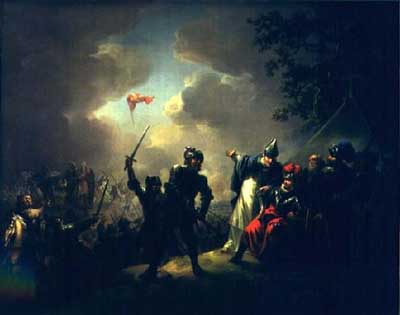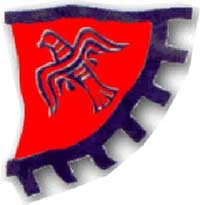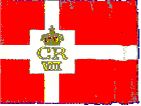|
You are here: 4The Flag 4History of the Flag |
|||||||||||||||||||||||||||||||||||||
|
|
||||||||||||||||||||||||||||||||||||
|
The first known Danish banner was the "Banner of the Raven" This banner was a piece of red cloth with a black raven. The Raven was the holly signature of the ancient Danish God, Odin. The banner was feared and well-known as the gathering point of the Vikings. During the time of the Danish Vikings raids against the Norman's in the early 11th century, the Banner of the Raven became the national symbol. In the year 1016 the Danish King Knud the Great was leading his men into the battle at Ashington in England, waving the Banner of the Raven. This Banner, or piece of cloth was later known as the Dannebroge, the Dane's cloth. Later on the name was said as the Dannebrog. |
The Raven Banner. |
During the period of the Christianizing of the Dane's, the old black raven was replaced by the white cross.
The legend of the Dannebrog
Suddenly there was a great peal of thunder, and a red banner with a white cross floated down from the sky.
This is the story known to most Dane's as the origin of the Dannebrog.
This event happened June 15, 1219. The place was Lyndanisse in Estonia.
According to this legend, in the year 1219 the Danish King, Valdemar 2nd, led an attack against the pagan Estonians. His goal was to conquer them and make them Christian.

The historic moment, Dannebrog
floating down from the sky
on June 15, 1219.
(Painting by C A.
Lorentzen)
The legend states further that the banner fell into the arms of Danish archbishop; a voice from the skies said: "When you raise this banner against your enemies, they will yield before you". The archbishop immediately sent a messenger with this banner to King Valdemar on the battlefield.
The King waved the banner high; and this miraculous sign from heaven encouraged the Dane's, and gave them their final victory.
There is, however, no historical evidence to document this ancient legend. The first pictures of the red flag with the white cross dates back to the mid 14th century.
But legend or not; since that long, the Dannebrog has been the national symbol of the Dane's, even though the Dane's were not allowed to fly the Dannebrog before 1854.
Until 1854 the Dannebrog was the symbol of the King and the State; and since 1912 the day of June 15 has been proclaimed the Day of the Flag, Valdemar's day.
Swallow Tailed or Square Flag
On several occasions through the 15th and 16th centuries the Danish Kings had to proclaim, that the swallow tailed Dannebrog was to be used only by the King and flying from his ships.
|
May 20, 1635 the King Christian IVth issued a resolution stating that Danish merchantmen shall fly the Dannebrog as a square flag. Around 1750 Danish merchantmen passing through the Strait of Gibraltar an sailing the Mediterranean area should fly a squared Dannebrog with the Royal Insignias. The main purpose was to protect the Danish merchantmen from North African pirates and to avoid any confusion with the Flag of the Maltese. |
The Danish
square flag |
One could watch this squared flag with the Royal insignia flying up until 1867.
Dannebrog becomes the Danes' own Flag
The Danes to day make frequently use of their flag.
Right up until the 1830s, Dannebrog symbolized the royal household and the state.
Actually King Frederik VIth in 1834 passed laws prohibiting the use of flag by ordinary people.
Nevertheless Dannebrog was often used in popular festivities all over the country.
In 1854 the Danes are allowed the private use of flying the Dannebrog, - and they do it...
|
Sources: |
||
|
& |
Fra Flaadens arkiver - Dannebrog fra kongebanner til orlogsflag og fane, by Commander s.g. Th. Bjerre, Vaabenhistorisk Selskab, Copenhagen 1958 |
|
|
& |
Om Dannebrog jeg ved..., edited by Jesper Hjermind and Kristian Melgaard, Forlaget Viborg I/S, Viborg, 1995 (ISBN 87-90281-00-4) |
|
|
& |
Rigets Flag paa batteriet Sixtus 1788 - 15.8 . 1988, by H. C. Bjerg, published by the Naval Material Command, Copenhagen, 1988 |
|
|
& |
Vort flag, Forlaget Codan, Copenhagen 1943 |
|
44You are also referred to the Naval Bibliography
![]()
- Do you miss a major event on this Site,
or do you hold a great story?
Are you able to contribute to the unfolding of
the Danish Naval History,
please
e-mail
me, enclosures are welcome.
Please remember to list your sources.
You can also use the Naval Web Forum on this web-site.
![]()
-
This page was last updated: May 3, 2006
This page was first published: September 16, 2001
Copyright © 2013-2016 Johnny E. Balsved - All rights reserved - Privacy Policy




